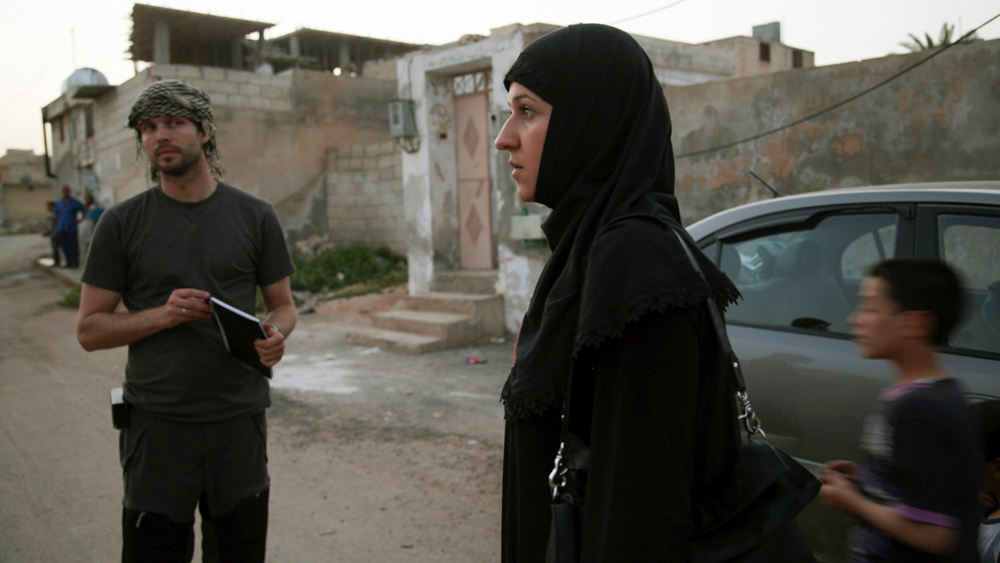When Katy Chevigny and Ross Kauffman traveled to the mountains of Telluride, Colorado in May for the Mountainfilm Festival, they wound up sharing a gondola with a pair of tween girls and their mother who had just seen their film “E-Team.” Excited by the adventures of Human Rights Watch’s emergency team of investigators, particularly the flame-haired and fearless Russian operative Anna Neistat, the girls’ enthusiasm led Kauffman to pull out his phone to coordinate some international relations.
“They’re asking me some questions about Anna,” recalled Kauffman, “And I said, ‘Hold on. Let me just put her on Skype.’ Literally, on the gondola, they had their own personal Skype Q&A with her.”
Chevigny and Kauffman have become accustomed to making such connections across borders and time zones at at the drop of a hat, having spent the last four years tracking two sets of E-Team investigators into conflict zones. Friends since first meeting at Sundance in 2004 when their films – Chevigny’s “Deadline” and Kauffman’s “Born Into Brothels” – made waves at the festival, the two filmmakers decided to form one supergroup to follow another as they would divide their time joining Neistat and her husband Ole Solvang on their missions to Syria in the days after the 2011 uprising and Peter Bouckaert and Fred Abraham, who are dispatched to Libya where they race against the clock to record testimony detailing how the since-deceased Muammar Gadaffi was killing political prisoners.
Despite their mandate to report what’s happening on the ground in war-torn regions and disseminate it to news organizations around the world, Bouckaert likens the E-Team’s approach to criminal investigators rather than journalists, a distinction Chevigny and Kauffman might apply to their own film, with the additional sense of danger and thrills that implies. Opening with a nerve-jangling scene in an apartment complex in Syria where the mere sound of airplanes overhead could portend an imminent bombing, the film never lets up the suspense as the E-Team ventures into places neither governmental agencies or most journalists would dare go, even as it takes detours into the E-Team members’ personal lives to show what extraordinary effort is put into balance a career of international crimesolving with mundane domestic responsibilities as driving home the kids and gardening.
An engrossing rollercoaster of nonfiction filmmaking at its finest, the film will stream right into every house with a Netflix account later on October 24th simultaneous with its release at the Laemmle Royal in West L.A. and the IFC Center in New York, but before it does, Chevigny and Kauffman sat down to talk about how they joined forces, “E-Team”‘s remarkable timeliness and how sticking with their characters led to the most thrilling version of their story.

Katy Chevigny: When we had the idea of doing this film, we met the members of the Emergencies team. It was almost like a blind date. We all had dinner in Manhattan. We just got along great. We didn’t talk much about the film or doing the film. Katy and I left that dinner, we were walking down the street saying, “They’re wonderful characters. They’re obviously totally diverse and they all have incredible stories.” And we thought at that point they’d make a great film.
One of the most intriguing elements of the film is how you show the E-Team balancing out their domestic life with their professional one. Was that always part of the plan?
Katy Chevigny: Yeah, in our first grant proposals. We said we’re also going to film them at home and learn about what makes them tick, why they do what they do. Ross and I were very much in sync that that would be what would make the film work.
How did you know which members to focus on?
Ross Kauffman: At that point, there were six or seven members – it fluctuates. When we met these four, we thought they’re the most established members of the E-Team. They’ve been there the longest. It was very clear that they would be the core of the film. We never really thought “Let’s have more characters.”
Katy Chevigny: They were the main members. A couple new ones were added over time. The first time we met them, they were it. Now they’ve expanded.
This film is remarkably timely, considering the heightened conflict in Syria right now. If you even had an inkling, did it influence how you structured the film?
Ross Kauffman: No. Katy and I really specialized in making verite documentaries, so you’re following the story as it’s happening. We had no idea. When we first started the film, we didn’t even know if they would be going to Syria or Libya. There was an initial meeting that we filmed that was just before the Arab Spring started in January of 2011. The whole conversation was about Pakistan. No one had any inkling what was going to happen, nor did we.
Katy Chevigny: The real reason that we started following the story of Syria is because we were filming Anna and Ole at home and it was the beginning of the protest turning into civil war, so we thought “Okay, this will be a story that we can follow from the beginning” as opposed to Libya where we came in the middle. We didn’t know what was going to happen in Syria, but we actually thought it might be a short little story and we’d be done filming in six months. Maybe al-Assad would fall. Then it turned into such a complicated and sad situation in Syria that’s gone on for years. Anybody following it got drawn in, we got drawn in to tracking what was happening and staying involved.
Ross Kauffman: Everyone was hoping it would be a short story.
There’s a moment in the film where a man in Aleppo, Syria is being interviewed by investigators about how he just lost his brother and sister and what’s interesting is that he turns away from them and towards your camera. Were you actually considerate of your presence there and what it might mean?
Ross Kauffman: It was interesting being in the field with them because we had to keep a very small footprint. We could only have one person. We couldn’t be a camera person. There couldn’t be an additional sound person. There couldn’t be a producer. There’s literally a camera person who’s doing everything. That was part of the structure and the agreement with them – we’d keep a small footprint and their work always came first.
If there was ever a moment that anyone was out in the field – whether it was myself, Rachel Beth Anderson or Jim Foley – it was always about their work. When they’d say, “Put the camera down” you put the camera down. We just follow their lead. Oftentimes, Human Rights Watch actually sends people who take photos or do video for them, so it’s not an extremely unusual thing for them. What was more unusual was going back home with them for them. It took them a while to get used to that.
There’s another scene in which Anna’s in Syria and her fixers are joking to each other in Arabic how sexy she is and she’s unaware since she doesn’t speak the language and I’d assume you wouldn’t, either until you had it translated. Was it interesting to shoot things unaware of what was transpiring to some degree?
Katy Chevigny: Ross and I would watch the footage as soon as we could after a mission, often before it was translated. We had hours and hours and we would watch scenes and make notes saying we know there’s something interesting there, we need to get this translated soon because we really want to hear what they’re saying. That was certainly one of those scenes and one of the interesting things about doing a project like this is that there’s a whole other layer revealed after you translate.
Was it difficult then sometimes to know what leads to follow?
Ross Kauffman: For us, the leads we’re following are our characters. Where they went, that’s where we went. There was never a time where we said “Hey, let’s go that direction because it will be good for the film.” When w were home with them we would definitely ask them certain questions and try to gain some insight into who there were and what made them tick. But when it came to following leads, it was all about just figuring out what missions to go on, when to shoot, why we would go on a certain mission because it’s not like we have unlimited funds to go on every single mission. That’s when we had to pick and choose. Our producer Marilyn Ness was great about saying “You know what? I really think this is a mission that we should go on.” We’d all talk about it and we all really collaborated when it came to what to shoot.
This is maybe a good moment to also mention David Teague, our incredible editor. David did an incredible job of executing the vision that Ross and I were offering him and then also was very much [focused on] keeping it to these guys. We’re not going to get into a whole bunch of extraneous stuff, other things related to Syria [for instance]. In that way, the viewer can stay grounded and connected to the film throughout, which was smart and it was great because it kept it simple [for Ross and I] too.
Ross Kauffman: When we first conceived of this film, we wanted to make a movie. We didn’t want to make a documentary. We wanted to make a character-driven movie where people hung on the words and the actions of our characters as opposed to the issues [at hand].
Was there a particularly insane moment for you while making this? I’ve read Rachel Beth Anderson say her craziest day was at the Turkish border, smuggling the Anna into Syria.
Ross Kauffman: There’s a lot of insane moments whether they’re in Paris, Geneva or Syria or Libya and a lot of wonderful and really sad moments.The fact that we can come and go but there’s these people – the Syrians and the Libyans – are stuck there and they can’t get out, it was about finding the hope in those sad and crazy moments that we really tried to capture…
Katy Chevigny: The joy and the humor. That was another thing Ross and I were really on the same page about. It can be very dark material, but we very much believe that it’s part of our role as storytellers to show the range of emotions in the lives of everyone in the film… We feel excited that people are connecting with the characters in the way we hoped. In some ways, that was our ultimate goal. That’s the beauty of them being a team. Some people connect with Peter, some with Fred and some with Anna. They’re different, but there’s points of connection to be had at lots of places.
Is it true you’re thinking about turning this into a series? These globetrotting investigators certainly lend themselves to such a format.
Ross Kauffman: It’s ripe for a series. Just the structure of it just makes sense for a series, whether it was fictional or even documentary. It’d be wonderful because they’re incredible characters and obviously there’s no lack of places that are going through these terrible circumstances and I think we learned something different from each place and each person that we followed.
What did you learn?
Ross Kauffman: I think a big part of our job is to go into these stories without any preconceived notions. Not to expect something to happen but just to be open as we’re filming. With that said, we were surprised everyday. Not only with what [the E-Team] accomplished, but sometimes with what they didn’t accomplish and they tried to accomplish. The success and the failures.
Katy Chevigny: Over time, we were both increasingly impressed with how hard the work is on so many levels, mentally as well as their tenacity. They never give up.
Ross Kauffman: They never give up. Physically, mentally or emotionally. I thought that someone would have an iota of absolute frustration, but it didn’t happen. That’s really pretty incredible.
“E-Team” opens on October 22nd at the IFC Center in New York and October 24th at the Laemmle Royal in West Los Angeles, where Chevigny and Kauffman will be doing Q & As on the 24th and 25th. A full list of theaters and dates is here. It debuts on Netflix on October 24th.




